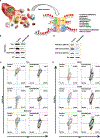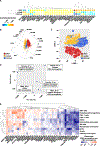Single-cell epigenetics - Chromatin modification atlas unveiled by mass cytometry
- PMID: 29960011
- PMCID: PMC6422338
- DOI: 10.1016/j.clim.2018.06.009
Single-cell epigenetics - Chromatin modification atlas unveiled by mass cytometry
Abstract
Modifications of histone proteins are fundamental to the regulation of epigenetic phenotypes. Dysregulations of histone modifications have been linked to the pathogenesis of diverse human diseases. However, identifying differential histone modifications in patients with immune-mediated diseases has been challenging, in part due to the lack of a powerful analytic platform to study histone modifications in the complex human immune system. We recently developed a highly multiplexed platform, Epigenetic landscape profiling using cytometry by Time-Of-Flight (EpiTOF), to analyze the global levels of a broad array of histone modifications in single cells using mass cytometry. In this review, we summarize the development of EpiTOF and discuss its potential applications in biomedical research. We anticipate that this platform will provide new insights into the roles of epigenetic regulation in hematopoiesis, immune cell functions, and immune system aging, and reveal aberrant epigenetic patterns associated with immune-mediated diseases.
Keywords: Chromatin; EpiTOF; Epigenetics; Histone post-translational modifications; Immune system; Mass cytometry.
Copyright © 2018. Published by Elsevier Inc.
Conflict of interest statement
Conflict of Interest
The authors declare no competing interests.
Figures



References
Publication types
MeSH terms
Substances
Grants and funding
LinkOut - more resources
Full Text Sources
Other Literature Sources

